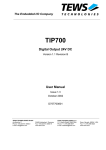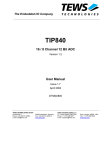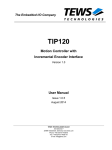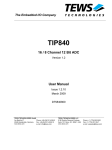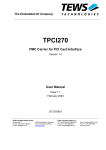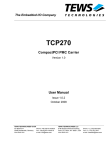Download TIP250 - TEWS Support Website in Taiwan
Transcript
The Embedded I/O Company TIP250 8 Mbytes Flash Memory Version 1.0 User Manual Issue 1.2 October 2008 TEWS TECHNOLOGIES GmbH Am Bahnhof 7 Phone: +49-(0)4101-4058-0 25469 Halstenbek, Germany Fax: +49-(0)4101-4058-19 www.tews.com e-mail: [email protected] TEWS TECHNOLOGIES LLC 9190 Double Diamond Parkway, Suite 127, Reno, NV 89521, USA www.tews.com Phone: +1 (775) 850 5830 Fax: +1 (775) 201 0347 e-mail: [email protected] TIP250-10 8 Mbytes Flash Memory This document contains information, which is proprietary to TEWS TECHNOLOGIES GmbH. Any reproduction without written permission is forbidden. TEWS TECHNOLOGIES GmbH has made any effort to ensure that this manual is accurate and complete. However TEWS TECHNOLOGIES GmbH reserves the right to change the product described in this document at any time without notice. TEWS TECHNOLOGIES GmbH is not liable for any damage arising out of the application or use of the device described herein. Style Conventions Hexadecimal characters are specified with prefix 0x, i.e. 0x029E (that means hexadecimal value 029E). For signals on hardware products, an ‚Active Low’ is represented by the signal name with # following, i.e. IP_RESET#. Access terms are described as: W Write Only R Read Only R/W Read/Write R/C Read/Clear R/S Read/Set ©2001 -2008 by TEWS TECHNOLOGIES GmbH All trademarks mentioned are property of their respective owners. TIP250 User Manual Issue 1.2 Page 2 of 11 Issue Description Date 1.0 First Issue December 2001 1.1 Added MTBF Value January 2002 1.2 Added Weight New Address TEWS LLC October 2008 TIP250 User Manual Issue 1.2 Page 3 of 11 Table of Contents 1 2 3 4 PRODUCT DESCRIPTION ........................................................................................... 6 TECHNICAL SPECIFICATION ..................................................................................... 7 ID PROM CONTENTS................................................................................................... 8 IP ADDRESSING .......................................................................................................... 9 4.1 I/O Addressing.................................................................................................................................9 4.1.1 Flash Control Register (FCR) ...................................................................................................9 4.1.2 Flash Status Register (FSR)...................................................................................................10 4.1.3 Interrupt Vector Register (IVR) ...............................................................................................10 4.2 Memory Addressing......................................................................................................................10 5 HINTS.......................................................................................................................... 11 5.1 5.2 Flash Memory ................................................................................................................................11 JTAG Connector............................................................................................................................11 TIP250 User Manual Issue 1.2 Page 4 of 11 Table of Figures FIGURE 1-1 : BLOCK DIAGRAM......................................................................................................................6 FIGURE 2-1 : TECHNICAL SPECIFICATION...................................................................................................7 FIGURE 3-1 : ID PROM CONTENTS ...............................................................................................................8 FIGURE 4-1 : REGISTER SET .........................................................................................................................9 FIGURE 4-2 : FLASH CONTROL REGISTER ..................................................................................................9 FIGURE 4-3 : FLASH STATUS REGISTER ...................................................................................................10 FIGURE 4-4 : INTERRUPT VECTOR REGISTER..........................................................................................10 FIGURE 4-5 : MEMORY STRUCTURE ..........................................................................................................10 FIGURE 5-1 : TYPICAL FLASH ACCESS TIMES ..........................................................................................11 FIGURE 5-2 : JTAG CONNECTOR ................................................................................................................11 TIP250 User Manual Issue 1.2 Page 5 of 11 1 Product Description The TIP250 is an IndustryPack compatible module that offers an easy and reliable way to implement 8 Mbytes of Flash memory. The TIP250 is ideal for holding application code, operating system software or data. Two AM29LV033 devices (32 Mbit, x 8 organized) are used to provide 1 bank of 8 Mbytes (16 bit wide) Flash memory, which is divided, into 64 sectors of 128 Kbytes (16 bit wide). Access to the TIP250 Flash memory occurs within the IP memory space. After power-on the TIP250 starts up in read only mode. The IP I/O space holds the Flash Control Register, the Flash Status Register and the Interrupt Vector Register. Figure 1-1 : Block Diagram TIP250 User Manual Issue 1.2 Page 6 of 11 2 Technical Specification IP Interface Interface Single Size IndustryPack® Logic Interface compliant to ANSI/VITA 4-1995 ID ROM Data Format I I/O Space Used, with no wait states Memory Space 8 MByte, with 1 wait state Interrupts Only INTREQ0# is used DMA Not supported Clock Rate 8 MHz Module Type Type I On Board Devices Memory 8 MBytes Flash Memory (4 Mbit x 16), implemented by two AM29LV033 (or compatible). Organized as 64 sectors of 128 KBytes Min. erase and program cycle endurance: 1 000 000 I/O Interface no connection to the IP I/O connector Power Requirements 160 mA typical @ +5V DC Physical Data Temperature Range Operating Storage MTBF 407000 h -40 °C to +85 °C -55°C to +125°C MTBF values shown are based on calculation according to MIL-HDBK-217F and MIL-HDBK-217F Notice 2; Environment: GB 20°C. The MTBF calculation is based on component FIT rates provided by the component suppliers. If FIT rates are not available, MIL-HDBK-217F and MIL-HDBK-217F Notice 2 formulas are used for FIT rate calculation. Humidity 5 – 95 % non-condensing Weight 25 g Figure 2-1 : Technical Specification TIP250 User Manual Issue 1.2 Page 7 of 11 3 ID PROM Contents Address Function Contents 0x01 ASCII ‘I’ 0x49 0x03 ASCII ‘P’ 0x50 0x05 ASCII ‘A’ 0x41 0x07 ASCII ‘C’ 0x43 0x09 Manufacturer ID 0xB3 0x0B Model Number 0x30 0x0D Revision 0x10 0x0F Reserved 0x00 0x11 Driver-ID Low - Byte 0x00 0x13 Driver-ID High - Byte 0x00 0x15 Number of bytes used 0x0C 0x17 CRC 0xFD Figure 3-1 : ID PROM Contents TIP250 User Manual Issue 1.2 Page 8 of 11 4 IP Addressing The control registers of the TIP250 are accessible in the IP I/O Space. The Flash memory of the TIP250 is accessible in the IP MEM Space. 4.1 I/O Addressing The complete register set of the TIP250 is accessible in the I/O space of the IP. Address Symbol Description Size (Bit) Access 0x01 FCR Flash Control Register 8 R/W 0x03 FSR Flash Status Register 8 R/W 0x05 IVR Interrupt Vector Register 8 R/W Figure 4-1 : Register Set 4.1.1 Flash Control Register (FCR) Read/Write Register to control basic features of the TIP250. Bit Symbol Description Access Reset Value 7 F_RST Reset flash memory Writing a “1” forces the Flash Memory into reset. A subsequently written "0" terminates the reset. Reset forces the flash memory into read-only state. Refer to the AM29LV033 data sheet for more details. R/W 0 6 WP Write Protect (active high) 0 = no write protection 1 = write protected (default after Reset) R/W 1 5 INT_EN Interrupt Enable 0 = interrupt disabled 1 = An interrupt is generated on IP INTREQ0# when the flash memory's state changes from BUSY to READY during WRITE or ERASE commands. Any write to the FSR clears the pending interrupt. R 0 4:0 - reserved R - Figure 4-2 : Flash Control Register TIP250 User Manual Issue 1.2 Page 9 of 11 4.1.2 Flash Status Register (FSR) Read/Write register. A read displays status information. Any write to the FSR clears the pending interrupt. Bit Symbol Description Access Reset Value 7:6 - reserved R - 5 INTSTAT Interrupt Status 0 = no pending interrupt 1 = interrupt is pending R 0 4 RDY/BSY# Flash Ready / Busy# signal if the flash devices 0 = Flash is busy 1 = Flash is ready R 1 3:0 - reserved R - Figure 4-3 : Flash Status Register 4.1.3 Interrupt Vector Register (IVR) Read/Write register. This register is cleared automatically during IP Reset. The Interrupt Vector must be loaded by software. Bit Symbol Description Access Reset Value 7:0 INTVEC Interrupt Vector loaded by software R/W 0x00 Figure 4-4 : Interrupt Vector Register 4.2 Memory Addressing Two AM29LV033 devices (each organized as 32 Mbit x 8) are used to provide 1 bank of 8 Mbytes (16 bit wide) Flash memory, which is divided into 64 sectors of 128 Kbytes (16 bit wide). Access to the TIP250 Flash memory occurs within the IP memory space. Refer to AM29LV033 datasheet for command sequence details. D [7:0] Am29LV033 Am29LV033 32 Mbit Flash 32 Mbit Flash ( 4 Mbyte ) ( 4 Mbyte ) D [15:8] Am29LV033 Am29LV033 32 Mbit Flash 32 Mbit Flash ( 4 Mbyte ) ( 4 Mbyte ) BANK 1 BANK 1 8 Mbytes Flash 8 Mbytes Flash 64 sectors of 128 Kbytes 64 sectors of 128 Kbytes 16 bit wide 16 bit wide Figure 4-5 : Memory Structure TIP250 User Manual Issue 1.2 Page 10 of 11 5 Hints No Configuration like e.g. Jumper setting is necessary for the TIP250. 5.1 Flash Memory The 8 MByte (4 MBit x 16) Flash Memory of the TIP250 is implemented by two AM29LV033 (or compatible) Flash devices. Typical access times: Bank erase time typ. 45 s Sector erase time typ. 0.7 s Word programming time typ. 9 µs Bank programming time typ. 36 s Figure 5-1 : typical Flash access times 5.2 JTAG Connector For factory programming of the on board CPLD, the TIP250 has a JTAG connector. This connector is only for factory use. See figure below for location of the JTAG connector. CPLD JTAG - Connector Figure 5-2 : JTAG Connector TIP250 User Manual Issue 1.2 Page 11 of 11













